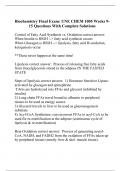Exam (elaborations)
Biochemistry Final Exam: UNE CHEM 1005 Weeks 9-15 Questions With Complete Solutions
- Course
- Institution
Control of Fatty Acid Synthesis vs. Oxidation correct answer: When Insulin is HIGH --> fatty acid synthesis occurs When Glucagon is HIGH --> lipolysis, fatty acid B-oxidation, ketogenesis occur **These never happen at the same time! Lipolysis correct answer: Process of releasing free...
[Show more]



